Ridgway's Rail
Latin: Rallus obsoletus
How an emerging wetland at the Salton Sea offers new hope for migratory birds and local communities.
Bombay Beach Wetland Project | Proyecto de humedales de Bombay Beach Photo: Emily Tozzi/Formation Environmental
The Salton Sea’s waterline continues to rapidly recede, leaving behind exposed playa that exacerbates respiratory diseases and other issues for nearby communities.
Unexpectedly, however, the shoreline’s recession has created an opportunity for nature to take its course, evident by the presence of newly emerging wetlands around the Salton Sea. There are roughly 6,000 acres of newly formed wetlands that have emerged around the Salton Sea. They are a product of agricultural outflows or from natural seeps from springs. In June of 2020, Audubon California released a report titled "Identifying Existing Areas for Habitat Protection/Enhancement and Dust Suppression Projects on the Salton Sea Exposed Playa" that assesses the amount and distribution of these wetlands.
Audubon California has received a grant from the United States Bureau of Reclamation that will fund project design, biological surveys, and community engagement for both dust suppression and the expansion, stabilization, restoration, and enhancement of 250 acres of these emerging wetlands near the town of Bombay Beach on the Salton Sea. These incidental wetlands can serve a dual purpose in creating vital habitat for migrating birds and mitigating the dust that endangers the respiratory health of the 650,000 people who live near the Salton Sea.
The existing Bombay Beach Wetland is located on the southeastern shore of the Salton Sea, about 3 miles east of the Bombay Beach community. It consists of a wetland and surrounding vegetation that has developed where several prominent washes converge and groundwater discharges. There are existing saline wetlands and brackish pond habitats for species including the Yuma Ridgway’s Rail, American Avocet, Northern Pintail, and possibly the Desert Pupfish.
The existing wetland will remain small, however, without restoration and stabilization. This is because the higher quality habitat area upslope is being increasingly dominated by a monoculture of the invasive Tamarisk plant. The wildlife species, however, are already using the area, despite the lack of formal restoration or management, indicating that there is an opportunity to enhance the area.
The Salton Sea as a whole is important for more than 300 species of resident and migratory birds. Additionally, where there is not wetland or vegetated habitats, there is bare playa that is responsible for dust pollution to the surrounding communities. It is imperative that these emerging wetlands at the Salton Sea be stabilized to ensure sufficient habitat along the Pacific Flyway and to mitigate dust pollution.

The Bombay Beach Wetlands project aims to stabilize and enhance various emergent and saline wetlands and playa habitats, protect human health by optimizing water use to promote dust suppression in nearby playas, and provide opportunities for recreational public access.
Wetland preservation and enhancement will be done by protecting existing vegetation, wetland, and aquatic habitat areas from damaging stormwater inflows with the reinforcement of shoreline berms that protect the area.
The reinforcement of berms, complemented by water-use optimization infrastructure, will allow for water to have a maximum environmental beneficial use. This project aims to optimize water use to irrigate vegetation around the adjacent playa for dust control, to maintain the salinity in wetland areas for optimal species productivity, and to enhance and promote new habitat in the wetland.
This project also aims to include outdoor recreation opportunities for the community and is receptive to public feedback on potential project design alternatives and public access ideas. We hope to make this emergent wetland an area that the public can experience, the birds can live in, and an area that can help mitigate public health issues.
The Bombay Beach Wetland Project is in the first phase, which is expected to take two years, which includes habitat and dust control project design, scientific monitoring and data collection, and community engagement in planning design. Following successful completion of this planning phase, groundbreaking on construction would start in 2023.
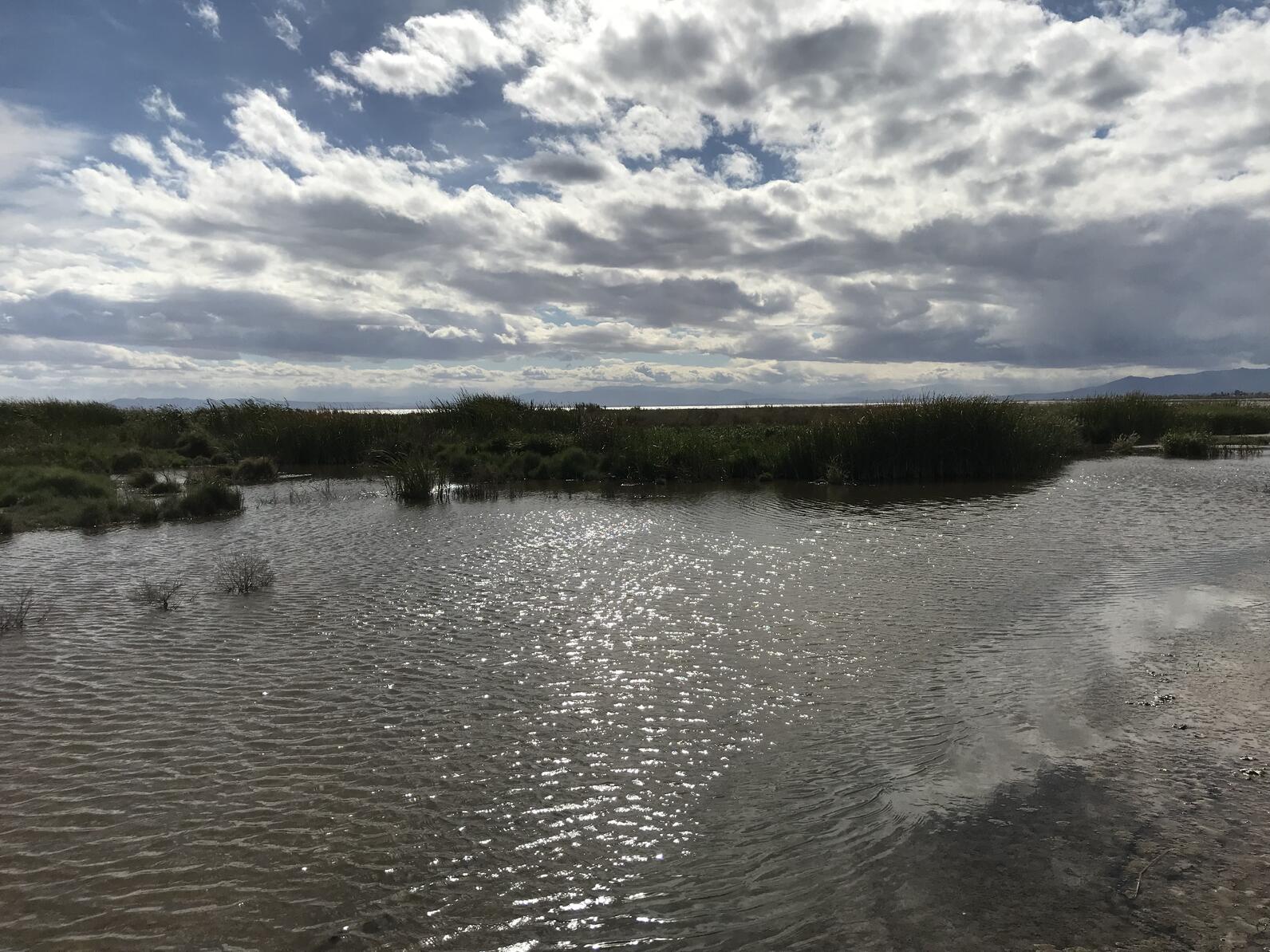
We are interested in getting public feedback and input on our project design and public access ideas. You can submit a public comment through our survey form here. Additionally, please join us for our second Community Advisory Meeting on Zoom to learn more about our project and share your ideas. We will announce this meeting on Facebook. The consultant for this project is Formation Environmental, LLC, with other groups pending as progress develops.
View our Frequently Asked Questions document, available both in Spanish and English, to get more information.
Funding for this project is being provided by the U.S Bureau of Reclamation. This project is being completed in cooperation with the Imperial Irrigation District and the California Department of Fish and Wildlife.
Coalition of conservation and community groups says groundbreaking is positive step towards ending years of inaction at California’s largest lake.
Discover the data and resources about the habitats and changes happening at the Salton Sea from across the network.
Audubon California releases report detailing emerging wetlands at the Salton Sea.
Estamos estrenando nuestra nueva, descargable guía de campo de algunas aves del Valle de Coachella, las cuales son culturalmente importante para los Cahuilla.
Our new, downloadable pocket field guide features some birds of the Coachella Valley that are culturally significant to the Cahuilla people of the Torres-Martinez Band.
Audubon science finds that two-thirds of North American birds are at risk of extinction from climate change.
The Los Angeles Times's Patt Morrison interviews Tim Krantz, a University of Redlands environmental studies professor, about what's at stake at the Salton Sea. An excerpt:
"If you had a 30-second TV spot to make your pitch for saving the Salton Sea, what would it say?
The sea is not an accident. It's not there in the isolated desert. It affects 1.5 million people who live around it. It's not a local, regional problem; it's much broader. To deal with it retroactively, only after thousands of people have lost their lives, only after property values from Palm Springs to the border have declined, only after the fish and wildlife values, the migratory bird values have been lost — we're facing the dilemma in perpetuity, trying to put Band-Aids on the problem. Or we can spend that money now and maybe get a return on our investment in short order."
Read the whole piece here.
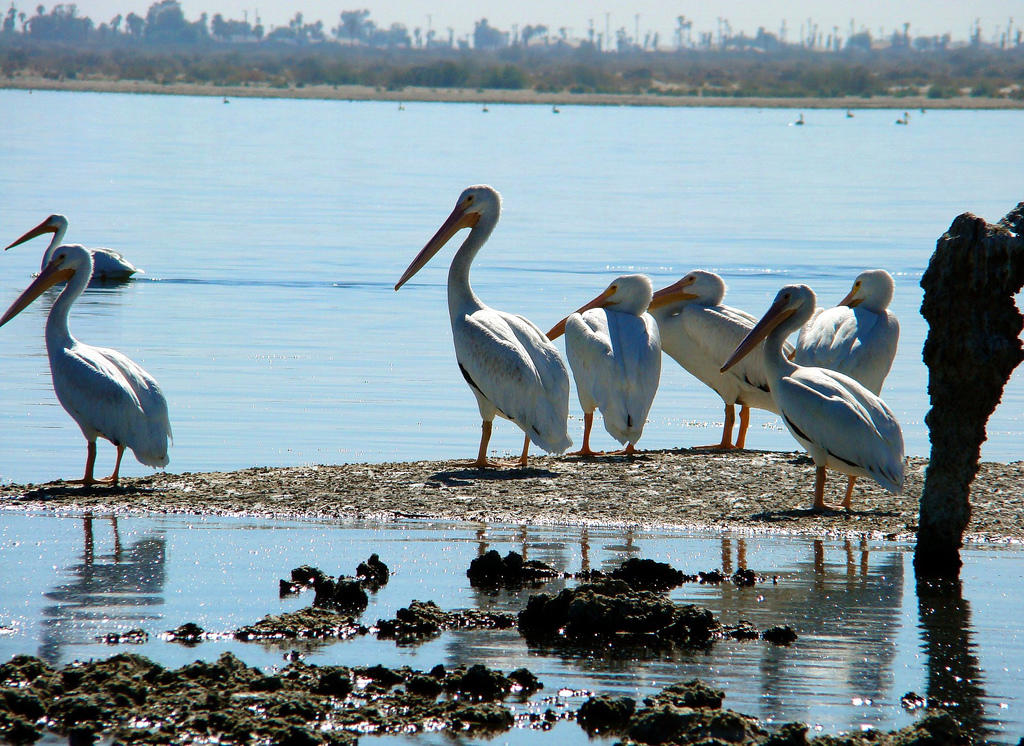
Conservation groups including Audubon California hope that more than $80 million included in the recently-approved state budget will be the first step in a longer, more substantial commitment from the Legislature to addressing the developing environmental crisis at the Salton Sea. The $80.5 million for planning and restoration at the Salton Sea, part of the $167 billion state budget, will ultimately come from Proposition 1 funds approved by voters in 2014.
While the new funding marks the largest amount that the State of California has ever contributed to restoration at the Salton Sea, it is nonetheless only a fraction of the several billion dollars that will be needed to stabilize the situation there.
The funding will help the state pay for the development of a long-term management plan that seeks to address the problems created by reduced water deliveries to California’s largest inland lake. As the Salton Sea shrinks in the coming years, it is expected to have serious ramifications for the more the 400 species of birds that rely on its habitat. Less water will also result in the exposure of hundreds of acres of plays, creating a toxic dust and a serious public health hazard.
Money will also jump-start restoration of habitat along the edge of the lake, creating infrastructure to move water to a number of habitat areas.
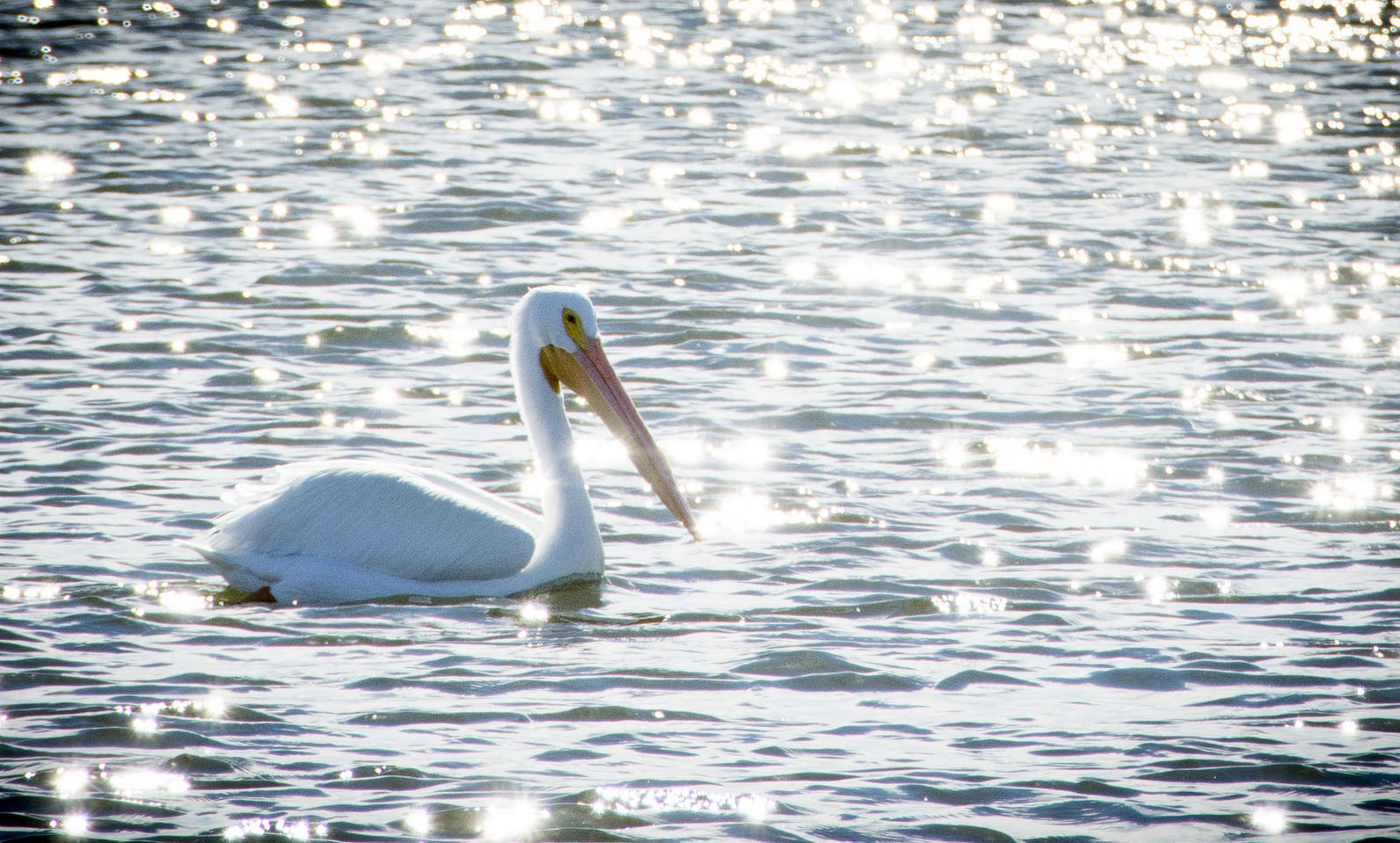
An independent California oversight agency last week called on California Gov. Jerry Brown to declare a state of emergency to resolve the environmental disaster unfolding at the Salton Sea. In a strongly-worded letter, the state’s Little Hoover Commission shared the results of recent hearings, arguing that the Salton Sea should be given as high a priority as high speed rail, the twin tunnels, reduced carbon emissions, and increased renewable energy.
The Commission is responding to the upcoming implementation of water diversions from the Salton Sea that will eventually result in 40 percent less water filling the state’s largest inland lake. This will have a devastating impact on bird habitat and expose huge swaths of lakebed, potentially creating dust that will present a serious public health threat to the 650,000 Imperial County residents nearby.
Audubon California is particularly concerned about the situation at the Salton Sea because of the regions particularly high value to birds. More than 400 species use the Salton Sea, many of which are threatened or endangered species.
“Unlike a wildfire burning out of control or an oil spill blackening beaches, the Salton Sea disaster is slowly unfolding, and has been all but ignored until recently,” the letter reads. “When other disasters destroy California lives and livelihoods, Governors declare a state of emergency. The looming Salton Sea disaster warrants the same level of urgency.”
The commission offered four specific recommendations to get the state’s response to this crisis moving.
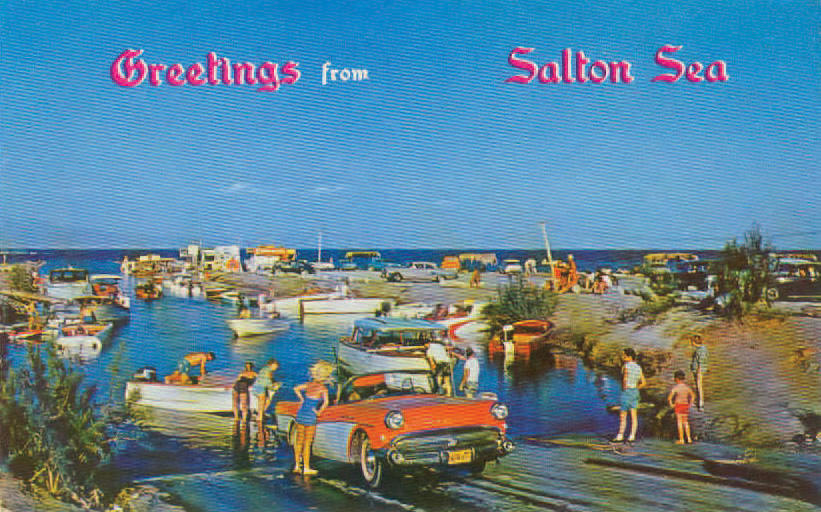
A picture says a thousand words, as the saying goes. The above postcard from the 1950s shows a bustling Salton Sea Marina, a center of fun and recreation.San Bernardino Valley Audubon's Drew Feldman recently visited the exact same location and took the photo below, which shows just how much things have changed over the years.
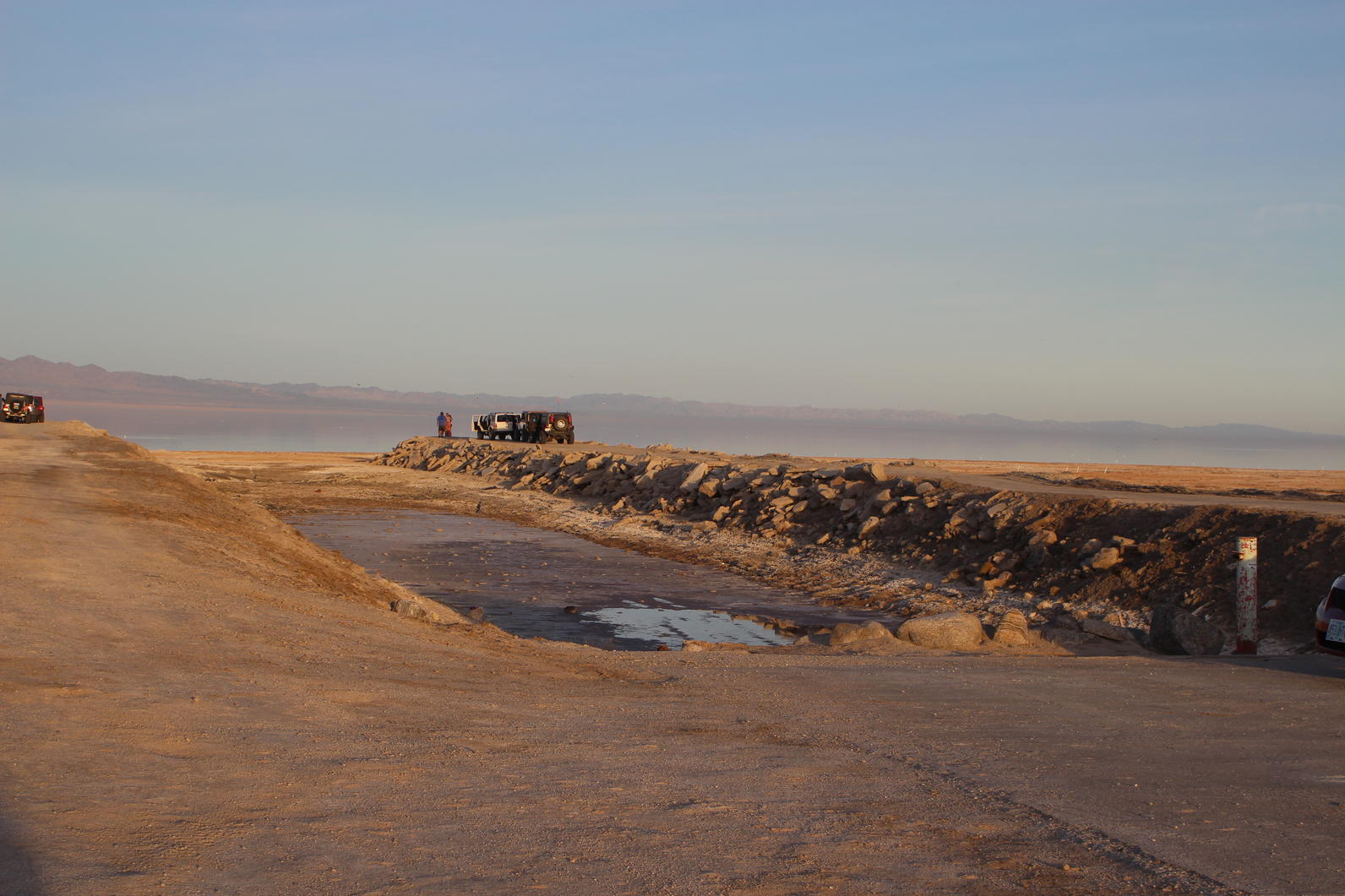
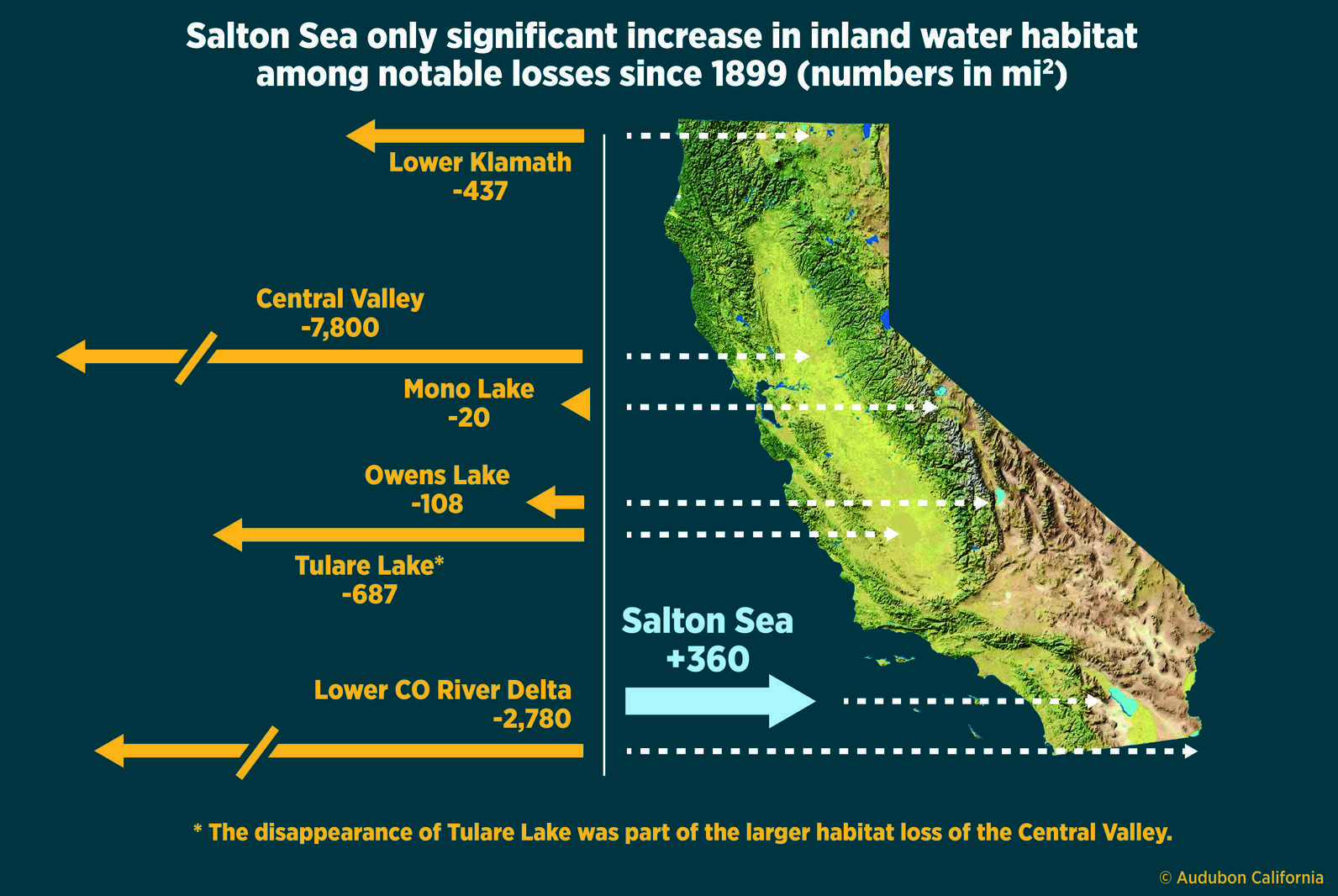
Audubon California Executive Director Brigid McCormack today writes in the Desert Sun that while the narrative around the Salton Sea is often one of environmental decay, the site remains one of the most important places for birds on the Pacific Flyway. She notes that it was created at a time when humans were wiping out natural inland water habitat:
"For birds, the creation of the Salton Sea came at just the right time – just as humans began wiping out wetland habitat throughout California.
Two years before dredging began on the Imperial Valley canal, the last remnants of Tulare Lake disappeared. Once the largest freshwater lake in the West, Tulare Lake was nearly twice the size of the Salton Sea, and anchored more than five million acres of Central Valley wetlands, 95 percent of which are now gone.
In 1906, the federal government began work on the Klamath Project, which eventually eliminated 437 square miles (80 percent) of wetland habitat in the Klamath Basin along the California/Oregon border.
Just a few years later, the Los Angeles Department of Water and Power began diverting water from the 108-square-mile Owens Lake, where Native Americans recalled a sky blackened with migratory birds, and naturalist Joseph Grinnell found great numbers of avocets, phalaropes and ducks. By 1926, Owens Lake was gone.

Fascinating piece today in the Los Angeles Times about the growing concern over declining water levels in Lake Mead that, if they continue to fall, could trigger substantial water cuts in Arizona and New Mexico. Because of this pressure is growing on California users to reduce its use of Colorado River Water. You might recall recently that the Imperial Irrigation District, one of the primary users of water from the Colorado River, has said that will be uncomfortable with any agreement regarding Colorado River water unless the major issues of habitat conservation and dust mitigation at the Salton Sea are resolved.
"All the parties are under pressure to reach an agreement by the end of this year, before the current administration leaves office and the process has to start anew with new federal overseers. But the interstate complexities may pale in comparison with the difficulty of working out agreements among water users within each state. California's Imperial Irrigation District, which has the largest entitlement of Colorado River water, has balked at any agreement to preserve water levels in Lake Mead without a parallel agreement to preserve the Salton Sea. That huge inland pond has suffered as a result of earlier multi-billion-dollar deals by which the Imperial Irrigation District transferred water to San Diego, the MWD and other users.
The shrinkage of the sea already is an environmental and public health disaster. Withholding more water in Lake Mead without a rescue plan would be unacceptable, Imperial Irrigation District General Manager Kevin Kelley said recently. "The Salton Sea has always been the elephant in the room in these talks," he told the Desert Sun newspaper."
When Audubon California talks about the Salton Sea, we often highlight that about 400 species of birds make regular use of this habitat -- massive numbers of sandpipers migrating between Alaska and South America, as much as 90 percent of the world’s Eared Grebes, and large numbers of American White Pelicans, Double-crested Cormorants, the threatened Snowy Plover. Without the Salton Sea, these species and many others would struggle for survival.
The two maps below offer another view of how birds from all over the Western Hemisphere use the Salton Sea. Since 1908, volunteers and researchers have been banding birds for the U.S. Geological Survey's North American Bird Banding Program, and so we have data on where we found birds that were banded at the Salton Sea, as well as where birds were banded that ultimately turned up at the Salton Sea.
Birds banded at the Salton Sea and found elsewhere
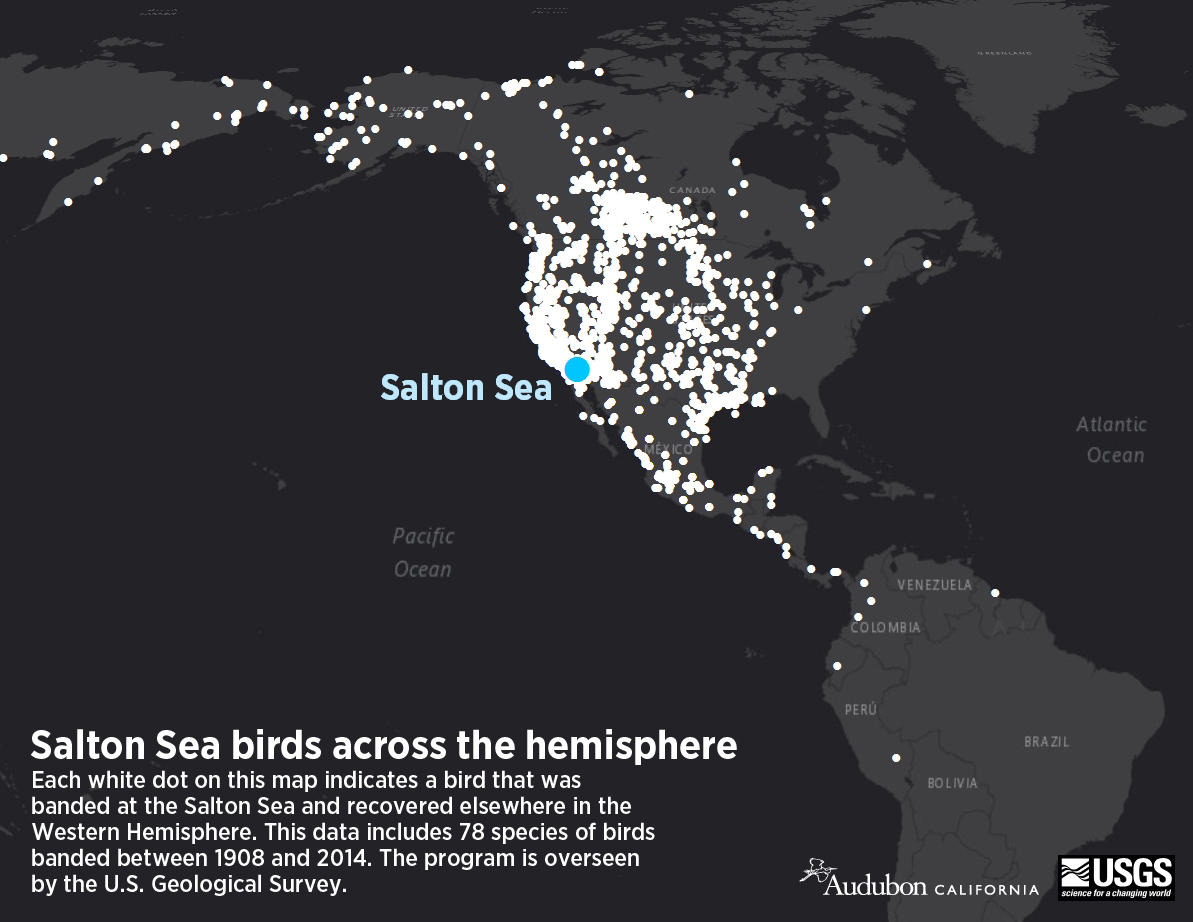
Birds banded throughout the Western Hemisphere and found at the Salton Sea

Our newsletter is fun way to get our latest stories and important conservation updates from across the state.
Help secure the future for birds at risk from climate change, habitat loss and other threats. Your support will power our science, education, advocacy and on-the-ground conservation efforts.
California is a global biodiversity hotspots, with one of the greatest concentrations of living species on Earth.